 When did you last revisit your social profile on Twitter or Facebook?
When did you last revisit your social profile on Twitter or Facebook?
Do you want to maximize the impact of your social networking efforts?
Basic housekeeping tasks are necessary for maintaining complete and engaging profiles.

In this article, you'll find 26 tips, an A-Z guide, with recommendations to help you get the most of your social network profiles.
#1: Adhere to Image Sizing Requirements on Social Networks
If your customer arrives on your Facebook Page and sees your profile picture as either too small for the space or out of focus, there's a good chance they'll develop a quick impression. Something to the tune of, “If they couldn't get that right, what else will they get wrong?”
Here's a helpful cheat sheet with dimensions for image sizes on Facebook, Twitter, Google+ and more. Print it out and hang it over your desk.
#2: Beef Up Your Site With Multiple Social Share Buttons
We don't always have the benefit of knowing our customers' preferences for sharing content.
Make it easy for customers to share your content where and how they want.
Provide multiple sharing options so that your customers who prefer Twitter can tweet, those who love Pinterest can pin and your customers who have an affinity for Facebook can share your article there, etc.
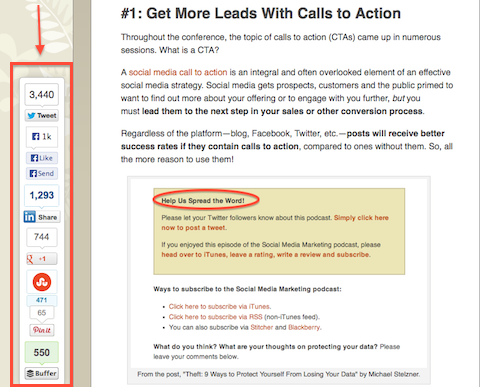
#3: Create Leads For Upcoming Events
Just because people hear about your event on a social network doesn't mean they know how to register or buy tickets.
Sean Carlos suggests, “Do ensure that event descriptions make it clear where official registration happens. It's too easy for users to assume that saying ‘I'm going' on Facebook is tantamount to an official registration. Seasoned event organizers will know differently.”
Include easy-to-follow registration links when you promote your company events online.
#4: Delineate Keyword-Rich Text on All Your Social Profiles
SEO and keywords aren't a thing of the past. In fact, with search engines delivering social network profiles in their results, they're more critical than ever.
Angela Lucas offers this advice about using your keywords on social media platforms, “The more you use a keyword, the more likely you're going to be associated with that keyword on a particular social platform.”
Get World-Class Marketing Training — All Year Long!
Are you facing doubt, uncertainty, or overwhelm? The Social Media Marketing Society can help.
Each month, you’ll receive training from trusted marketing experts, covering everything from AI to organic social marketing. When you join, you’ll also get immediate access to:
- A library of 100+ marketing trainings
- A community of like-minded marketers
- Monthly online community meetups
- Relevant news and trends updates
Use a tool like Google's Keyword Tool to make sure your business is associated with the right industry keyword!
#5: Encourage Customer Reviews
Lisa Fugere puts the issue of reviews in perspective. “Seventy-five percent of the businesses that you can find on social review sites have no reviews. That means that even if you've done nothing to bring your brand online, it likely already is.”
Encourage your customers to share their experiences on sites like Yelp, TripAdvisor or Urbanspoon.
#6: Feature Unique Hashtags
Hashtags, words or phrases prefixed with the symbol #, provide a means for grouping messages. Hashtags work well for making your content or event stand out in the crowd.
For example, Peet's Coffee & Tea uses #giveacup to draw attention to their Single Sip Truck visits.

Use descriptive hashtags to help keep your fans interested in and engaged with focused parts of your business or campaigns.
#7: Get Real on Social Networks
As your communities grow, it's easy for customers to feel as though they're lost in the crowd.
In 1936, Dale Carnegie wrote the landmark book, How to Win Friends and Influence People. In the book, Carnegie wrote, “Names are the sweetest and most important sound in any language.”
Go the extra step and use your fans' names when you respond to their questions or comments on social networks.
#8: Hunker Down and Add More Social Networks When and if You're Ready
How many new social networks have emerged since you first developed your online marketing strategy? It's possible a new channel might help you achieve a goal you're struggling with. Are your products and services a natural fit for Pinterest? Can Instagram extend the reach of your campaign with photos?
Binh Nguyen has a helpful directory that includes social network sites, micro-blogging sites, groups and social community sites, micro-video blogging sites and video-sharing sites.
Reassess your social sites and use the directory to identify new places to build a presence for your business.
#9: Insert Your Company Name in Your Blog's Title Tag and Meta Description
If your blog doesn't contain your business name, people searching for you may not be able to find you. Whole Foods Market has a blog entitled, Whole Story. Even though it's a catchy title, people searching for their blog won't necessarily know to search for “Whole Story.”
Include your company name in the Title Tag and the Meta Description on your blog to eliminate any potential problems. For example, Whole Foods uses “Whole Story | Whole Foods Market” as their title tag and “The Official Whole Foods Market® Blog” in their meta description.

#10: Jump-Start Search Results for Pinterest
Many social networks have settings that affect whether your profile will show up in search results.
For example, Pinterest has a settings option to keep your profile “private” from search engines.
To ensure that your content surfaces in search results, go to settings and switch “Search Privacy” to “No.”
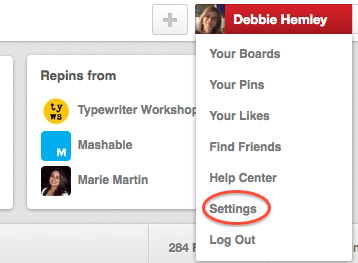
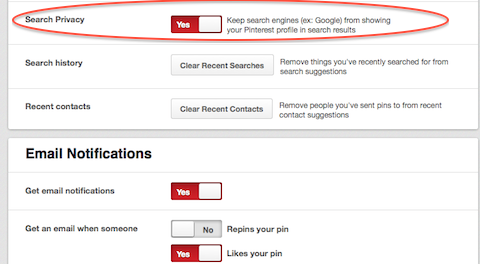
#11: Keep Your Focus on Perfect Blog Post Titles
A lot of time goes into the research and writing of your blog posts and one area that's easy to overlook is the title of the piece.
Tracy Gold writes that at the Content Marketing Institute they spend “an average of 30 minutes per title in search of the absolute best wording. That adds up to a good chunk of time, but what's the point of having an excellent blog post if its title won't draw in traffic?”
Title your posts with thoughtful keywords that will resonate with search engines and readers.
#12: Link Your Content With Google Authorship
Content is published at an astounding rate and it's easy for your articles to get lost in the masses of results that show up in a search.
Google Authorship links your content to your Google+ profile so that a photo is displayed next to your content in search results, along with a link to more of your relevant content.
Kristi Hines discusses Google Authorship along with many other ways to use Google+ to expand your business influence.
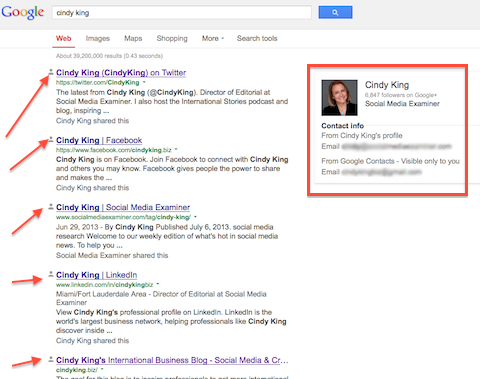 Way
Way#13: Make Signing Up for Your Blog by Email Easy and Inviting
Readers who discover specific blogs that they look forward to reading often want to receive updates about new articles right in their inbox.

Discover Proven Marketing Strategies and Tips
Want to go even deeper with your marketing? Check out the Social Media Marketing Podcast! Publishing weekly since 2012, the Social Media Marketing Podcast helps you navigate the constantly changing marketing jungle, with expert interviews from marketing pros.
But don’t let the name fool you. This show is about a lot more than just social media marketing. With over 600 episodes and millions of downloads each year, this show has been a trusted source for marketers for well over a decade.
For example, over 215,000 people have signed up to have the latest Social Media Examiner articles delivered to them.
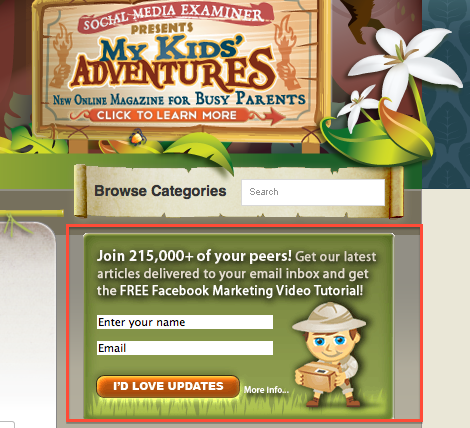
Use a simple form that's easy to complete and encourage readers to sign up for email updates about your new articles.
#14: Nurture Your Blog Posts With Titles That Match Content
Beyond the right words, blog titles create expectation about what the reader will find once they click on a link. Content that doesn't match the title's promise, or only offers a glorified sales pitch, will alienate readers and prompt them to click away.
Once you've gained a reader's attention, follow through on the promise of your title with content that delivers!
#15: Optimize Your Social Presences
As businesses add social profiles to their strategy at different times, it's easy to create profiles that don't share cohesive branding elements.
Pamela Vaughan advises, “First and foremost, you must make sure your presence is optimized. Make sure the bios/profiles for your social media accounts are complete and that they include clear and concise descriptions of your business, your company logo, and your website URL.”
Schedule regular housekeeping checks of your social network presences to keep information, logos and images up to date.
#16: Pack Your Social Media Markup Tags With Necessary Information
Barry Wise says, “Social media optimization (SMO) is the new SEO.”
KnowEm offers a free tool to analyze your SMO markup tags and help you find out where you can make improvements.
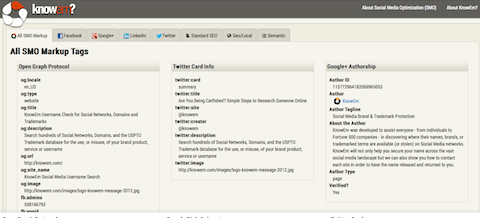
#17: Quit Hiding Your Picture
Are you an egghead on Twitter? A bluehead on Google+? Faceless on Facebook and LinkedIn?
Think of it this way: You go out in public every day, introduce yourself to people you've just met and give them the benefit of associating a face to a name. That shouldn't be any different on social networking sites.
Stephanie Frasco writes, “Your face is important. It shows who you are and that you're real. Beyond coming up in the search more often, you're also going to give members that trust factor that is often missing from social networks. This picture is important. It should give other members a good representation of you.”
Load your picture to the profile image on each of your social networks to help people recognize the public face of your business.
#18: Ramp Up Your Social Network Profile Bios
Often, businesses pay an incredible amount of attention to the visual elements of their social profiles and forget to complete the bio portions.
John Clark offers a number of suggestions: your bio should tell prospects what your company does and what benefits you deliver, leverage keywords while still offering prospects a compelling reason to engage, provide a free offer (e.g., download, trial, etc.), include a link to a landing page with a targeted message instead of your homepage, be visual and make every word in your bio work hard.
Review your social bios every three months to ensure they're in line with your current value proposition.
He's captured the basics in the reference tool below:
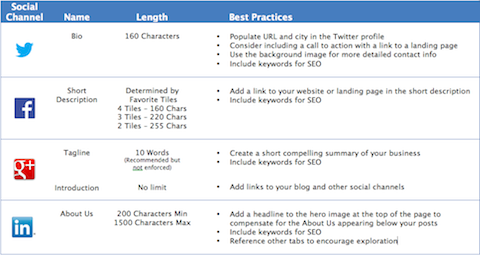
#19: Select Prominent Places for Social Network Links
Have you ever landed on a website and had to hunt around to see whether the business has social networking pages? Some are buried down deep in the navigation structure, or even placed under something like the “About Us” page.
While there's not really a tried-and-true de facto place that people adhere to, some businesses gravitate to the upper-right corner of their home page, some to the bottom of the page. Take a look around at other sites in your industry. Where are your prospects likely to expect to find your social networks?
If you want customers to find you on social networks, put your social network icons and links in a prominent place (or two) on your website.
#20: Tell Users About All of Your Social Presences
Coming on the heels of #19, don't forget to update your website with icons and links for new social networks as you integrate them into your strategy.
#21: Use Multimedia Content
John Walker makes a great pitch for using visual content to optimize social profiles. He writes, “Pictures, videos, slideshows and other multimedia content are a great way to make an impression on your social media profiles. Social media sites are increasingly leaning more toward visually oriented media. People just aren't reading text like they used to and multimedia content tends to be shared more. When you use visual content, you create a much more interesting and visually pleasing profile.”
#22: Vary Tweet Topics and Hashtags as New Products Emerge
Gaining traction for a new product or business can be difficult with all the noise traffic on social media today.
Hashtags offer a great option for focusing engagement and promoting interest. Twitalyzer provides great analytics for Twitter profiles and you can use it to track hashtag usage within your account.
If you find that your brand frequently uses a specific hashtag, consider adding a new one to highlight a product that needs a visibility boost.
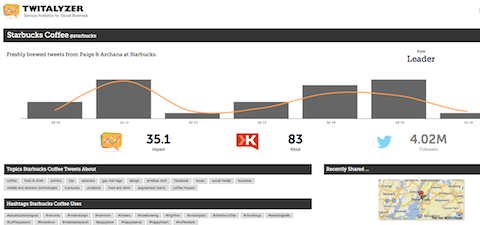
#23: Widen Your Reach
Finding sources and experts for articles you're writing is an essential part of the process.
Create a list of companies and people who are talking about topics you're writing on. The lists can be public or private and will help widen your reach of people to use as sources or to exchange information with.
In addition to Twitter lists, Listly can help you maintain lists of topical URLs and see curated lists of people who have information that might be helpful to you.
#24: Excel on YouTube With “About” Descriptions
Incomplete profile descriptions can leave viewers wondering about who you are and what you do.
YouTube can be a very powerful platform for a business. Here again is another example of a place where companies may miss the mark by failing to fill out the About company field.
Whole Foods Market took advantage of the About field on their YouTube channel. Peet's Coffee & Tea didn't include any text.
Are you on YouTube? Be sure to include a description of your business.
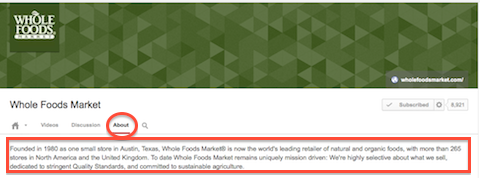

#25: Yield to Negative Comments
Businesses on social media will likely encounter a customer who feels wronged in some way. If they can't reach someone within your organization on your website or with a customer service number, they may choose to enter through a different door and post their complaint on one of your social networking sites or Yelp.
Address complaints offline and one-on-one with your customers to make them feel heard and respected. You will instill the confidence that you've promised and they've come to expect.
#26: Zero in on Social Network Visibility
As the number of social networks you use multiplies, the task of keeping track of their elements can become daunting.
When you use the same keywords, descriptions and other common company information time and again, you may find it helpful to create a file where you can keep all your profile information together.
Dana Lookadoo shares a helpful Online Visibility Worksheet for optimizing social media profiles and tracking profile information.
Over to You
What do you think? How many of these tips have you used? Did you see some that can help maximize the impact of your social networking? Share your experiences in the comment box below.
Image from iStockPhoto.
Attention Agency Owners, Brand Marketers, and Consultants

Introducing the Marketing Agency Show–our newest podcast designed to explore the struggles of agency marketers.
Join show host and agency owner, Brooke Sellas, as she interviews agency marketers and digs deep into their biggest challenges. Explore topics like navigating rough economic times, leveraging AI, service diversification, client acquisition, and much more.
Just pull up your favorite podcast app, search for Marketing Agency Show and start listening. Or click the button below for more information.

